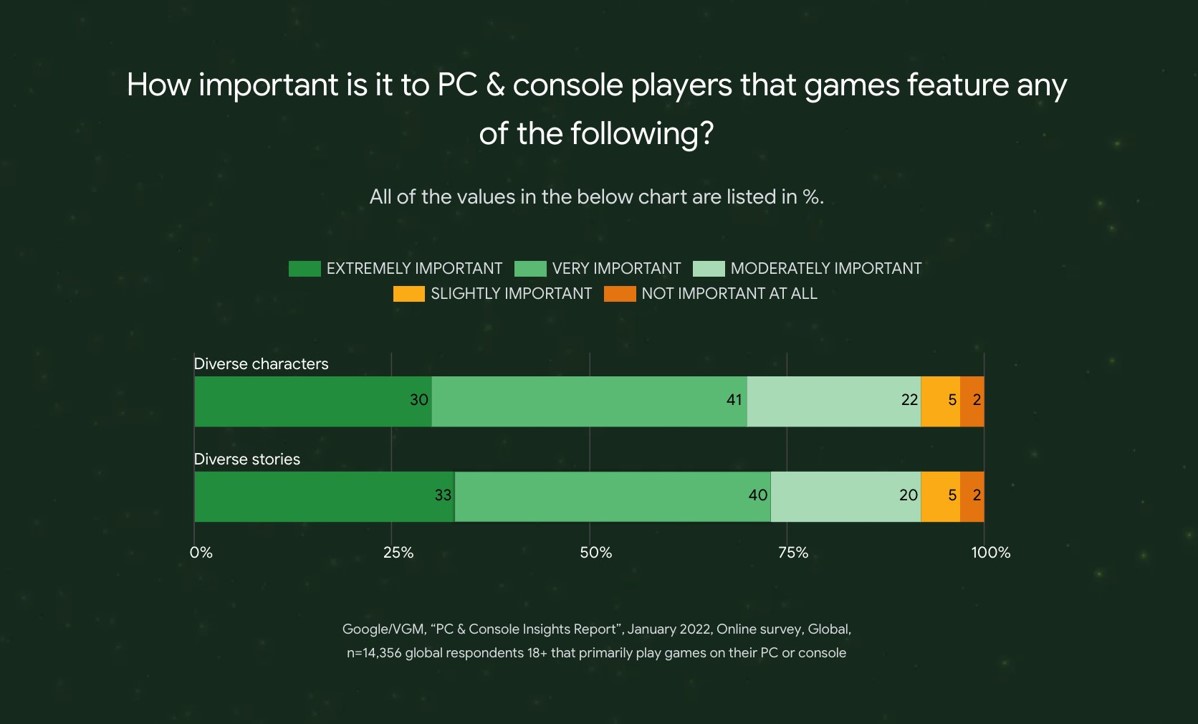PRODUCT INCLUSION ACTION
Co-create with Community

Involve the identities of people who you seek to represent in your development and creation process from beginning to end, in your staff, feedback channels, research and community engagement.
Customer Challenge
Underrepresented groups like women, ethnic minorities, the LGBTQIA+ community, and people with disabilities remain underserved, unseen, and inaccurately represented in many games.
Business Impact
Research shows that players prefer to play characters that look like them and are more likely to purchase and play experiences where they align to the characters identity.
- 57% of players in the broader gaming market didn't play certain games because the games weren't made for them. Over half of the global gaming market.
- Roughly 64% of players in the gaming market agree that diversity in games is important.
- 53% of developers felt diversity in storytelling should be a priority and it was ranked as the third most important factor in industry growth.
- 42% of shoppers said they would pay a premium of 5% or more to shop with a retailer committed to diversity & inclusion.
- 41% of retail consumers have shifted 10% or more of their business away from brands that do not reflect their value in diversity & inclusion.
References: Newzoo 2020 D&I Report, Newzoo 2023 Global Gamer Study

Source: 2022 Google PC & Console Insights Report
Questions to Consider
- Are you telling new stories or sharing new perspectives within the product experience?
- Do all of your characters/player depictions look the same?
- What steps have you taken to ensure characters are represented respectfully and are relatable?
- How have you validated assumptions you've made about your audience to check for blind spots or unintended stereotypes?
- Would you feel proud to show a member of a community how their culture/character is depicted within your experience?
- How are the wide range of customers depicted within your products, content portfolio, and communications?
- What process have you used to validate how different groups of people or cultures are represented in your experience?
- Do you have a process to review key decisions with the lens of Helping Customers Feel Seen?
Steps to Achieve It
1. Set Goals for what you want to achieve & share them with your project stakeholders
- Do planning at the start of projects to identify opportunities & obstacles.
- Go through the 10 Product Inclusion actions to bring intentionality into your designs.
2. Game Content
- Use feedback & data from underrepresented communities to inform your product goals.
- Whenever possible hire writers, artists, talent and other creatives with the lived experience you want to appear in your product.
- Even with creatives with the same lived experience, build in time to validate their output with others of the same lived experience through advisory councils, consultants and/or user research. No person or small team can represent large groups of people.
- Take steps to identify and avoid cultural appropriation.
- Engage with Global Readiness teams to ensure community input and guidance doesn’t inadvertently lead you to inclusion issues in other markets.
3. Content Portfolio
- Seek content for your portfolio that will resonate with members of marginalized communities and global players.
4. Platform & Store Experiences
- Surface up content that depicts diverse characters, stories and creators.
- When personalizing surfaces think about how different community members might perceive value differently from others.
5. Marketing, PR and Communications
- Understand the inclusion priorities of the experience you are working to promote and look to bring that focus into your storytelling.
- Consider the range of character/player and creator depictions in your storytelling.
- Are you taking intersectionality into consideration? For instance, if you show a player in a wheelchair is that player always a white woman?
